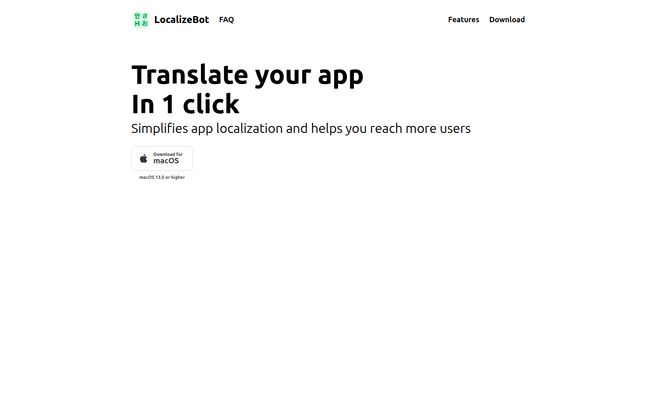If you're an app developer, the word “localization” probably either makes you sigh deeply or triggers a mild fight-or-flight response. We've all been there. Staring at a mountain of string files, trying to manage translations in a spreadsheet sent from a freelancer, and explaining for the tenth time that the button label “run” doesn’t mean jogging, it means execute the code.
It’s a tedious, thankless job that’s absolutely critical if you want to grow your user base beyond your home country. For years, it’s been a necessary evil. But recently, a new wave of AI-powered tools has promised to soothe this particular headache. I’m always a little skeptical, but I’m also a sucker for anything that claims to save me time. So when I stumbled upon a neat little utility called LocalizeBot, I had to take a look.
So What is LocalizeBot, Really?
First off, let's manage expectations. This isn't a massive, all-encompassing translation platform with human reviewers and project managers. And honestly? That's a good thing. LocalizeBot positions itself as a streamlined utility, a focused tool that does one thing and aims to do it well: translate your app's text using AI.
Think of it as a hyper-efficient Swiss Army knife for your Xcode project. It acts as a bridge between your app’s text files and the powerful AI brains of services like OpenAI and Google Cloud Translation. The whole process is disarmingly simple. You drag your files, you click a button, and you get translated files back. No fuss, no muss.

Visit LocalizeBot
The Features That Actually Matter to Developers
I’ve seen a million tools with flashy feature lists. But as a developer, I only care about the ones that actually solve a problem or fit into my existing workflow. Here’s where LocalizeBot caught my eye.
Seamless Xcode Integration (Finally!)
This is the big one for me. LocalizeBot works directly with .xliff and .xcloc files. If you’ve ever used Xcode’s built-in localization export feature, you know these files. This means you don’t have to change your process at all. You just export from Xcode as you normally would, drop the file into LocalizeBot, and then import the result back in. No weird conversions, no custom scripts, no nonsense. It just fits. That's a huge win in my book.
The AI Brains: OpenAI and Google Cloud
The tool lets you choose between two of the heaviest hitters in the AI space: OpenAI (the folks behind ChatGPT) and Google Cloud Translation. Having this choice is great. Sometimes one service performs better with certain language pairs or technical jargon than the other. This flexibility allows you to pick the engine that works best for your specific project. I appreciate not being locked into a single proprietary model.
Apple Glossaries: The Unsung Hero
Okay, this is the feature that made me nod in appreciation. LocalizeBot can automatically translate common UI text using Apple's own translations. Why does this matter? It ensures that words like “Save,” “Cancel,” “Done,” and “Edit” are translated exactly as they appear throughout the rest of iOS or macOS. It's a subtle thing, but it's the difference between an app that feels native and one that feels like a cheap, clunky port. It shows the creator of this tool actually understands the platform. It's a small detail that has a big impact on user experience.
Context is King, Even for Robots
One of the biggest failings of machine translation is a lack of context. LocalizeBot tries to tackle this in two smart ways. First, you can provide a brief description of your app. This gives the AI a frame of reference for your terminology. Second, it actually reads the comments in your localization files. So if you've left a note for a human translator like // 'term' refers to a period of time, not a word, the AI will take that into account. It's another one of those thoughtful, developer-centric features that I love to see.
The Good, The Bad, and The... Missing
No tool is perfect, right? After playing around with it, my feelings are mostly positive, but there are a few things to keep in mind.
The good is obvious: it's incredibly fast and easy. For an indie dev or a small team, this could be the difference between launching in one language versus five. It lowers the barrier to entry for global expansion, making it a powerful tool for rapid prototyping and market testing.
The bad is the inherent limitation of its core technology. Machine translation is amazing, but it's not human. For crucial marketing copy, or an app with very nuanced, emotional text, you're still going to want a native speaker to review the output. I’d use LocalizeBot to get 90% of the way there in minutes, and then pay a freelancer for an hour of their time to polish the remaining 10%. Thats a pretty good trade.
And then there's the missing piece of the puzzle: the price. I scoured the website, clicked on the FAQ, and... nothing. The FAQ page was broken, showing a “Content not found” error. Is it a one-time purchase from the App Store? Is it a subscription? Is there a free tier? I have no idea. This is a pretty major oversight. I’m really interested in this tool, but without knowing the cost, it’s hard to fully recommend it.
Who is LocalizeBot For? (And Who Should Skip It?)
So, who should download this thing right now? In my opinion, it's a perfect fit for indie developers and small teams. If you're bootstrapping a project and want to test the waters in a few different markets without dropping a grand on professional translation services, LocalizeBot is your new best friend. It’s also great for internal company apps or utilities where perfect prose isn't the top priority.
Who should probably stick to their existing workflow? Large enterprises with dedicated localization departments and massive budgets. If your app deals with sensitive legal or medical information, or if your brand voice is meticulously crafted, you need the nuance and cultural understanding that only a professional human localization team can provide. This tool is an assistant, not a replacement for that level of expertise.
Frequently Asked Questions
How does LocalizeBot handle Xcode files?
It natively supports the standard .xliff and .xcloc files that you can export directly from Xcode. This means it fits perfectly into the standard Apple development workflow without requiring any file conversions.
Can I translate my App Store description and keywords?
Yes, LocalizeBot can handle the translation of your App Store metadata, which is crucial for App Store Optimization (ASO) in different regions.
Is the AI translation perfect?
No AI translation is perfect. While services like OpenAI and Google are incredibly advanced, they can miss cultural nuances, idioms, or specific context. It's highly recommended to have a native speaker review the translations, especially for user-facing marketing copy.
How much does LocalizeBot cost?
As of late 2023, the pricing information is not available on the LocalizeBot website. The link to the FAQ page, which might contain this information, appears to be broken.
What makes LocalizeBot better than just using Google Translate directly?
The main advantages are workflow integration and context. LocalizeBot handles the parsing and re-packaging of Xcode's specific file formats, considers your code comments, and uses Apple's own glossaries for UI consistency—features you wouldn't get by just pasting strings into a web translator.
Final Thoughts on LocalizeBot
LocalizeBot is a really promising tool. It’s sharp, focused, and built with a clear understanding of the pains developers face. It doesn't try to be everything to everyone. Instead, it zeros in on the most tedious part of the localization process and automates it beautifully.
It successfully turns the daunting task of app translation from a multi-day headache into a ten-minute task. The biggest cloud hanging over it is the mystery of its business model. But assuming the price is reasonable, I can see this becoming an indispensable utility in my developer toolbox. It's a fantastic example of AI used not to replace us, but to act as a powerful, time-saving assistant. And I'm all for that.
Reference and Sources
- LocalizeBot Official Website
- OpenAI
- Google Cloud Translation
- Apple Developer Documentation on Exporting Localizations



